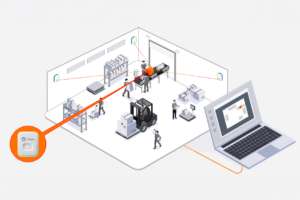Contents
Real-Time Location Systems (RTLS) are an invaluable tool for the aviation industry. RTLS technology allows you to track your airport ground support equipment in real time and make decisions about its location without having to manually search for it.
This information can help improve efficiency, reduce operational costs, and increase safety for both aircraft and personnel. Let’s take a look at why aviation RTLS is important for GSE tracking.
What Is RTLS And How Does It Work In Aviation Ground Support Equipment (GSE)?
Real-Time Locating Systems, or RTLS, is a type of location-tracking technology that uses tags to identify and track the movement of people, animals, and objects in real time.
The system uses RFID (Radio Frequency Identification), Wi-Fi, Bluetooth Low Energy, NFC (Near Field Communication), or other wireless technologies to transmit information about a tagged item’s identity and location. This information can then be used for a variety of applications such as asset tracking, inventory management, access control, personnel monitoring, and more.
How Does RTLS Work with Aviation GSE?
In the aviation industry, RTLS can be used to track Ground Support Equipment (GSE) such as luggage trolleys, cargo carts, wheelchairs, refueling trucks, and aircraft tow tractors. By affixing tags to GSE assets such as these and using an automated tracking system powered by RTLS technology, airlines can monitor their ground support assets in real-time.
This provides operators with greater visibility into the whereabouts of all their assets at any given moment so they can better manage their GSE fleet utilization rates. Additionally, using an automated asset tracking system powered by RTLS enables early identification of potential hazards and swift location of misplaced equipment when necessary – saving time and money while ensuring the safety of passengers on board flights.
Finally, having visibility into the movement of GSE assets also helps ensure compliance with FAA regulations related to aircraft servicing times since airlines can track exactly how long each piece of equipment was used for a specific task during each shift or day.
This ensures that aircraft service times remain within FAA-prescribed limits – resulting in improved safety ratings for airports and greater customer satisfaction for travelers alike.
How Can RTLS Be Used To Improve Safety And Efficiency In GSE Operations?
RTLS technology offers several advantages for GSE operators.
First, it helps improve safety by reducing the risk of collisions between GSE vehicles or aircraft due to misplaced equipment on the tarmac. With accurate tracking capabilities, ground crew members can quickly spot any potential hazards before they become a problem.
Second, RTLS improves efficiency by allowing operators to more accurately deploy resources based on immediate needs. This means fewer wasted materials or time spent searching for misplaced items on the tarmac.
Third, RTLS provides detailed analytics about each piece of equipment’s performance over time which can be used to anticipate maintenance needs and fuel consumption rates or schedule preventive maintenance measures before a problem occurs. This data can also be accessed at a later time, eliminating the need for manual filing, management, storage, and retrieval.
Benefits of RTLS in the Aviation Industry
The aviation industry has always been a demanding and competitive sector, with on-time performance and safety being at the forefront of every airline’s operations.
Improving On-Time Performance and Visibility
One of the primary benefits that RTLS has brought to the aviation industry is improved on-time performance. By using RTLS aviation, airlines can track aircraft, cargo, and other assets in real-time and ensure that they arrive at their destination on schedule.
This helps reduce delays caused by unforeseen circumstances such as weather or equipment failure, saving valuable time, and money. In addition to improving on-time performance, RTLS also allows airlines to better predict potential delays so they can make adjustments early on to minimize any disruption for travelers.
Enhancing Safety
The use of RTLS also provides an enhanced level of safety for passengers and crew by allowing airlines to quickly locate passengers or personnel who may be in distress or require assistance while onboard a flight or during ground operations.
The RTLS system can provide a continuous 360-degree awareness of nearby objects at the airport. When the forklift comes close to another piece of equipment or person, our proximity alert software signals with a visual and audible warning, prompting the operator to slow down or come to a complete stop to avoid a collision.
This technology can also be used to track aircraft and monitor their health status to ensure they remain compliant with safety regulations while in flight. Additionally, using RTLS technology can help detect any potential security threats before they become an issue by flagging any suspicious activity or unauthorized access attempts.
Reducing Operating Costs
Another major benefit that RTLS brings to aviation is cost savings due to its ability to streamline operations by making tasks more efficient and reducing manual labor requirements.
Better Efficiency
Another key benefit of using RTLS is that it makes processes more efficient by streamlining communication between personnel and assets. By utilizing real-time location data, managers can easily manage complex operations with fewer resources while still maintaining quality control over operations.
Additionally, this data can be used to optimize processes by identifying bottlenecks or areas of inefficiency within operations, allowing managers to make more informed decisions about how best to allocate resources.
Challenges in Implementing RTLS for GSE Tracking
Real-time locating systems (RTLS) are revolutionizing the way the aviation industry undertakes GSE fleet tracking. But before you invest in an RTLS system for your GSE fleet tracking needs, it’s important to understand the potential challenges that may arise during implementation.
Cost & Maintenance Concerns
One of the main concerns when implementing an RTLS system is cost. While many factors contribute to the total cost, some of them include hardware, software, installation, and maintenance costs.
It’s important to consider all associated costs when evaluating an RTLS system to ensure that it fits within your budget. Additionally, you will need to factor in maintenance costs over time as any hardware components may need servicing or replacing at some point down the road.
Integration Issues
Another possible challenge with implementing an RTLS system is integration with existing systems and processes. An effective GSE tracking solution should be able to integrate with other systems like asset management solutions, fleet management solutions, and/or building automation systems to create a fully automated solution that can streamline operations and improve efficiency.
If you want a fully automated solution with no manual data entry required, then you will need to ensure that the RTLS services you choose can easily integrate with your existing systems or processes without too much hassle.
Accuracy & Performance Issues
Finally, accuracy and performance issues can also arise when using an RTLS system for GSE tracking purposes. Poor signal strength or interference from outside sources can lead to inaccurate readings and even false alarms if not properly mitigated.
Additionally, sluggish response times can cause delays in operations if they are not addressed quickly enough. To ensure optimal accuracy and performance of your new RTLS system, be sure to select one that is designed specifically for use in industrial environments like airports or hangars where RF interference may be present.
Security Concerns
Finally, security should always be a top priority when considering any new technology, especially one that involves tracking sensitive data like GSE locations. Before committing to any RTLS system, make sure that you understand exactly how secure the data will be and what measures will be taken to protect against potential security breaches or unauthorized access.
This includes making sure that all staff members who have access to the data have appropriate training on how to handle it responsibly and securely. Regularly check on your credentials to ensure specific operator validation for various tasks.
How Can You Ensure A Successful RTLS Implementation For Your GSE Operation?
If you’re looking to implement an RTLS solution for your GSE operations, several key considerations need to be taken into account to achieve a successful implementation.
Define Objectives & KPIs
Before you can begin implementing an RTLS solution, it’s important to first define your objectives and key performance indicators (KPIs). What do you want to accomplish with this implementation?
Are you looking to reduce wait times on the ramp? Or Improve safety by tracking personnel in real-time? Or Increase efficiency by optimizing turnaround times?
These objectives and KPIs should be clearly defined so that they can be measured once the RTLS is implemented.
Understand Your System Requirements
Once you have a clear understanding of your goals and objectives, you must identify your system requirements to ensure that your particular needs will be met. Different systems offer different features and capabilities so you must understand what features are necessary for your operation before making a decision on which system is best suited for you.
Additionally, consider how much data storage capacity is needed as well as how often data needs to be uploaded or downloaded from the system for it to meet your operational needs.
Define Installation Requirements
Once you’ve decided on an RTLS solution for your GSE operations, any installation requirements must be properly defined. This includes determining where each device should be placed to get maximum coverage on the ramp as well as ensuring that all hardware components are compatible with each other and up-to-date with any software updates or patches needed for optimal performance.
Also, consider any additional training requirements needed for personnel to effectively use the system after installation is complete.
Invest in Litum: The Best Option For Aviation RTLS Solutions
To make sure you hit the nail on the head, using a tried and tested provider like Litum to create a connected network of vehicles, GSE, and staff is key.
Litum is here to provide you with the most reliable and cost-effective Aviation RTLS solutions that will help elevate your organization’s capability to coordinate airport services. Our system allows users to access real-time data for personnel in the field or near a GSE asset to gain increased visibility into their operations for improved efficiency, safety, and cost savings.
With Litum’s highly advanced technology, businesses can rely on optimized GSE operations that are aligned with their budget as well as regulatory requirements in aviation. Whether it is Employee tracking, Asset tracking, or Maintenance tracking, Litum offers customized services to best suit your aviation requirements.
Contact us today to get an efficiency boost in your airport ground handling and maintenance operations.



